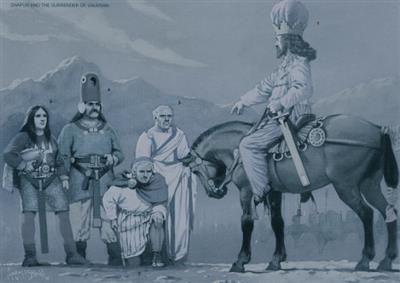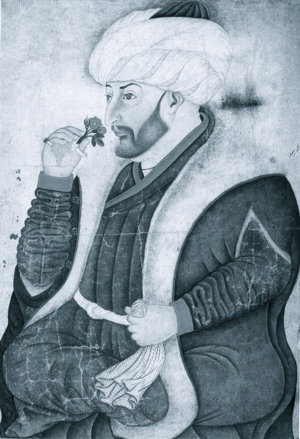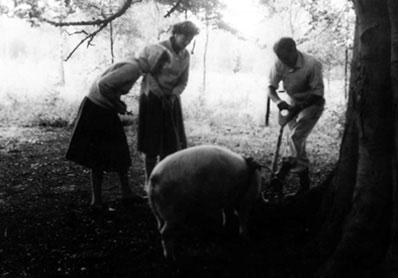Truffle Timeline
2000 BC The first known text about the truffle is acknowledge by the Neo- Sumerians on Clay tablets.
500 BC A foreign resident of Athens is given citizenship as a reward for inventing a new way to prepare truffles.
 300 BC The truffle come out in A History of Plants, the work of Greek philosopher Theophrastus.
300 BC The truffle come out in A History of Plants, the work of Greek philosopher Theophrastus.
AD 400 The oldest living truffle recipes can be found in the first known European Cookbook, Apicius, which register cooking and dining in Imperial Rome. Enclosed are six recipes for cooking truffles, a recipe for wine sause made with truffles, and methods of storing truffles in sawdust. The author is believed to be Marcus Gavius Apicius, a gourmand who lived during the reign rule of Augustus and Tiberius.
AD 350-500 Truffles develop a sinister reputation during the Dark ages; they are considered a sign of the presence of the devil and believed to be grown from the spit of witches. During the inquisition, the truffle is described as "black as the soul of the damned" and forbidden from the kitchen because of it seductive appeal.
AD 1000 Truffles are featured in the medical writings of the Persian physician Avicenna (considered the forefather of modern medicine) as a treatment for healing wounds, weakness, vomiting, and pain. The variety of truffle he wrote about, the Terfezia or desert truffle, is now known to contain antibiotics.
AD 1100 The Carpentras truffle market is set up in Provence, and is still held every Friday morning from November to March. In 1150 Raymond V, Count of Toulouse, insists on its exclusivity and banish the creation of all other markets between the Ouveze and Sorgue rivers.
 AD 1316 Pope John XXII is in set up in Avignon and plats oak trees nearby in hopes that truffles will follow.
AD 1316 Pope John XXII is in set up in Avignon and plats oak trees nearby in hopes that truffles will follow.
AD 1500 A sixteenth- century travel writer describes the sight of twenty-five or thirty camels with truffles being transported from the mountains of Armenia and Turkey, where they where grown, to the market in Damascus. A love for truffles in the region traces back to ancient Babylonia, where they were plentiful along the banks of the Euphrates and Tigris rivers.
AD 1526 French king Francois discovers the black truffle during his capture in Madrid and reintroduces it to France upon his return, serving mounds of them at banquets at the court in Fontainebleu.
AD 1533 Catherine de Medicis introduces the white truffle (tuber magnatum) to France.
AD 1651 Francois Pierre de la Varenne includes than sixty truffle recipes in Le Cuisinier Francois, text of modern French cuisine, and is the first chef known to pair truffles with foie grass.
AD 1808 The beginnings of the golden age of tuffles: joseph Talon creates the first cultivated truffiere, or truffle plantation, by planting acorns from oak trees that were already known to produce truffles. Soon he becomes the largest truffle producer in the region. He is, of course, widely copied.
AD 1810 A Frenchman, Nicolas Appert (1749-1841), creates a method that allows for the conservation of all manner of foods, including truffles, thus preservating their flavor and perfume. Napoleon Bonaparte had offered an award of 12000 francs to the person who could invent a useful way of preservating food for his army. After fifteen years of experimentation, Appert succeded, his method was to fill thick, large-mouthed bottles with foods of every description, ranging from beef, poultry, eggs, and milk to prepare dishes. He left air space at the top of the bottle and sealed it with a cork and a metal wise. The bottle was wrapped in canvas to protect it, then cooked in boiling water. To this day, canned French truffles and truffle juice may note on their label "Extrait par Appertisation" (Extracted by the Appert Method).
 AD 1847 August Rousseau, a truffle grower in Carpentras, plants seventeen acres of oak trees from acorns gathered beneath truffle-producing oaks. His harvest is huge and receives a prize at the 1855 World's Fair in Paris.
AD 1847 August Rousseau, a truffle grower in Carpentras, plants seventeen acres of oak trees from acorns gathered beneath truffle-producing oaks. His harvest is huge and receives a prize at the 1855 World's Fair in Paris.
AD 1863 Vineyards in France suffer and phylloxera epidemic. In a region where the land is favorable to truffle growth, oak trees replace vines, and intensive truffle production begins in earnest.
AD 1892 A record year for truffles in France: 2200 tons (2000 tonnes).
AD 1910 French truffle production declines to 1100 tons (1000 tonnes).
AD 1914 World War I continues, truffle production decline, farms are abandoned and left unattended.
AD 1940s Truffle production continues to decline, to 410 tons (400 tonnes).
AD 1950s Production falls to less than 10 tons (11 tonnes) in the worst years.
 AD 1960 French truffle production increases to 132 tons (120 tonnes).
AD 1960 French truffle production increases to 132 tons (120 tonnes).
AD 1977 In France, the first truffle is unearthed beneath an artificially mychorrizalized tree (one inoculated with truffle spores). Today, about 80 percent of all truffles in France are found beneath trees that have been inoculated with truffle spores.
AD 1985 French Truffle production declines again, to 66 tones (60 tonnes).
AD 1987 Research chemists discover for the first time the aromatic constituents of the black truffle. This discovery makes it possible to create an artificial truffle aroma, available on the market today as scented truffle oil.
AD 2010 Truffle production in France declines to 31 tons (30 tonnes), though with positive climatic conditions, the number could almost double.





